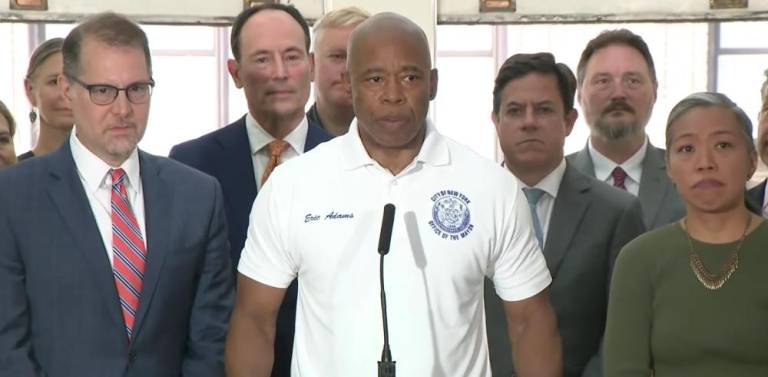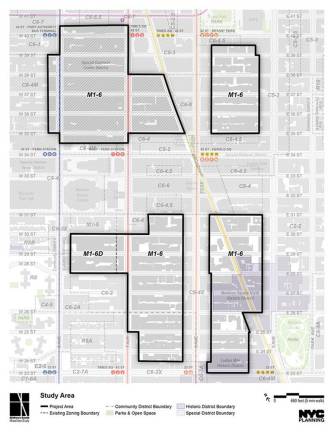Mayors Adams Proposes New Plans to Turn Vacant Midtown Offices Into Apartments
Most significantly, a new complement to Adams’s “City of Yes” plan called the “Midtown South Neighborhood Plan” aims to rezone 42 blocks, all in the hope of transforming unused commercial spaces into residential buildings. Manhattan Borough President Mark Levine explained to Straus News how the Neighborhood Plan is expected to be hammered out with some help from an upcoming zoning text amendment.
As a grim housing shortage plaguing New York has shown no signs of abatement, Mayor Eric Adams held a Tuesday, August 17 press conference on his three-pronged plan to convert vacant Midtown offices into residential units.
Flanked by Manhattan Borough President Mark Levine and at one point handing the mic to District 4 City Council Member Keith Powers (who represents part of Midtown), Adams displayed faith that a new “Office Conversion Accelerator” and “Midtown South Neighborhood Plan” could add onto efforts to turn NYC into a “City of Yes” that provides a roof over the heads of roughly 20,000 residents.
“With these three initiatives—converting empty offices to homes, an Office Conversion Accelerator, and the Midtown South Mixed-Use Neighborhood Plan—we continue to use every tool at our disposal to increase the supply of homes for New Yorkers,” Adams crowed.
Department of City Planning (DCP) director Dan Garodnick chimed in to proclaim that “we are ready to deliver smart zoning changes that will throw a lifeline to underused office buildings and create much-needed housing in the process.”
Keith Powers, who is the Majority Leader of the City Council, basically gave his stamp of approval to the whole slew of proposals: “Converting empty office buildings to apartments is an obvious course of action that must be pursued aggressively. The proposals announced today will expedite conversions and help create thousands of sorely needed housing units.”
Out of the colorfully named initiatives Adams advertised, the Midtown South Neighborhood Plan is the most concrete. While the City of Yes program seems to be a generalized way to insert widespread affordability and carbon-neutrality into the housing stock, and the Office Conversion Accelerator appears to be a centralized contact point for commercial interests hoping to have a say in residential zoning, the Midtown proposal hopes to get the ball rolling on housing conversion right away.
Described as a “community planning process,” the Neighborhood Plan will attempt to rezone 42 blocks into order to create a “more vibrant, 24/7 mixed-use neighborhood.” According to the city, the general boundaries for the project will be “West 40th Street to the north, West 23rd Street to the south, Fifth Avenue to the east, and Eighth Avenue to the west.” Priorities will include introducing permanently affordable housing, upgrading the potential for office-to-residential conversions, and investments in neighborhood improvements. Notably, the “preservation of important commercial and light manufacturing uses” is also highlighted.
“In February, my office released a plan that identified 171 sites and nine neighborhoods that could provide much-needed housing. I’m thrilled to see that one of them — Midtown South — is moving forward,” Borough President Mark Levine said of the Neighborhood Plan.
Levine notified Manhattanites of the stagnant state of new residential units entering the market on August 10, tweeting that data for the entire month of July indicated that Manhattan developers had started construction on approximately “Zero buildings. Zero units.” He described this as a “crisis.” This followed a Real Estate Board of New York report that demonstrated a forty-one percent Q2 decrease in new year-over-year building development.
In an interview with Straus News, Levine brought up a “huge citywide zoning text amendment that is coming down the pike” this fall and is expected to be approved next spring, which was mentioned at the press conference but didn’t receive the same banner attention as the flashy “City of Yes” or Neighborhood Plan.
Essentially, it will be be the wonky meat on the bones of the whole project, as it will “include provisions that make it easier to convert [offices to housing],” Levine said. He added that possible amendments will make it easier to “have infill on a campus,” or will give developers “a floor area bonus for adding affordable units.”
As far as the Midtown South Neighborhood Plan goes, Levine pointed to the quirks of development history to partially explain why affordable housing hasn’t yet cropped up in the area. Since the Garment District comprises a sizable chunk of the area targeted for rezoning by the plan, it means that those blocks are “currently zoned for manufacturing, bizarrely. At one point, obviously, there was a lot of manufacturing there...but it’s crazy that in 2023 that’s still the zoning.”
Levine clarified that he admires the legacy of clothing production that gives the neighborhood its identity, of course, but he claims that “only two percent” is still actively being utilized for that purpose. In other words, it’s high time to let some affordable housing into the mix.
With remote work surging and commercial real estate facing dire straits in Manhattan this year, a broad plan to recreate the usage of skyscraper sq. footage will surely only expand in the months ahead.

